Consequences of Anthropic Actions in Cullera Bay (Spain)
Abstract
1. Introduction
2. Area of Study
- Between 1947 and 1956, two groins of the same size were built at the mouth of the Júcar to channel the river’s outlet into the sea and prevent it from closing due to the accumulation of sediments. In the 1980s, the groin located to the north of the mouth was extended.
- In the same period (1947–1956), a groin was built between Racó beach and Cap Blanc beach.
- Taking advantage of the previous groin, at the end of 1978, work began on a marina. Thus, on Los Olivos beach, the beginning of an L-shaped breakwater was built, which was removed in November 1992 because the breakwater was a barrier to the circulation of the waves that caused erosion on Racó beach. Besides, 18,000 m3 of sand from Cap Blanc was dumped at the northern end of this beach so that the waves themselves would follow the dynamics naturally.
- In 1994, 40,000 m3 of sand was deposited along the entire length of the Racó beach with materials from the Cap Blanc and Los Olivos beaches. In 1995, the Racó beach promenade was rebuilt, and 20,000 m3 of sand was dumped from nearby beaches.
- In the last decades (1990–2019), there were hardly any modifications in the infrastructures that produced geomorphological alterations in the study area.
3. Materials and Methods
3.1. Shoreline Evolution and Land-Use Change
3.2. Sediment Distribution
3.3. Maritime Climate
4. Results
5. Discussion
6. Conclusions
Supplementary Materials
Author Contributions
Funding
Acknowledgments
Conflicts of Interest
References
- Xian, G.; Crane, M.; Su, J. An analysis of urban development and its environmental impact on the Tampa Bay watershed. J. Environ. Manag. 2007, 85, 965–976. [Google Scholar] [CrossRef] [PubMed]
- Sanjaume, E.; Pardo-Pascual, J. Erosion by human impact on the Valencian coastline (E of Spain). J. Coast. Res. 2005, 49, 76–82. [Google Scholar]
- Naik, D.; Kunte, P.D. Impact of port structures on the shoreline of karnataka, West Coast, India. Int. J. Adv. Remote Sens. GIS 2016, 5, 1726–1746. [Google Scholar] [CrossRef]
- Jiang, S.; Hu, R.; Feng, X. Influence of the construction of the Yantai West Port on the dynamic sedimentary environment. Mar. Georesour. Geotechnol. 2017. [Google Scholar] [CrossRef]
- Newton, A.; Carruthers, T.J.B.; Icely, J. The coastal syndromes and hotspots on the coast. Estuar. Coast. Shelf Sci. 2012, 96, 39–47. [Google Scholar] [CrossRef]
- Gómez-Pina, G.; Muñoz-Pérez, J.J.; Ramírez, J.L.; Ley, C. Sand dune management problems and techniques, Spain. J. Coast. Res. 2002, 36, 325–332. [Google Scholar] [CrossRef]
- Touili, N.; Baztan, J.; Vanderlinden, J.-P.; Kane, I.O.; Diaz-Simal, P.; Pietrantoni, L. Public perception of engineering-based coastal flooding and erosion risk mitigation options: Lessons from three European coastal settings. Coast. Eng. 2014, 87, 205–209. [Google Scholar] [CrossRef]
- Malavasi, M.; Santoro, R.; Cutini, M.; Acosta, A.; Carranza, M.L. What has happened to coastal dunes in the last half century? A multitemporal coastal landscape analysis in Central Italy. Landsc. Urban Plan. 2013, 119, 54–63. [Google Scholar] [CrossRef]
- Zanuttigh, B. Coastal flood protection: What perspective in a changing climate? The THESEUS approach. Environ. Sci. Policy 2011, 14, 845–863. [Google Scholar] [CrossRef]
- Salazar, A.; G Lizano, O.; J Alfaro, E. Composición de sedimentos en las zonas costeras de Costa Rica utilizando Fluorescencia de Rayos-X (FRX). Rev. Biol. Trop. 2004, 52, 61–75. [Google Scholar]
- Pagán, J.I.; López, I.; Aragonés, L.; Garcia-Barba, J. The effects of the anthropic actions on the sandy beaches of Guardamar del Segura, Spain. Sci. Total Environ. 2017, 601, 1364–1377. [Google Scholar] [CrossRef] [PubMed]
- Brown, I. Modelling future landscape change on coastal floodplains using a rule-based GIS. Environ. Model. Softw. 2006, 21, 1479–1490. [Google Scholar] [CrossRef]
- Budetta, P.; Santo, A.; Vivenzio, F. Landslide hazard mapping along the coastline of the Cilento region (Italy) by means of a GIS-based parameter rating approach. Geomorphology 2008, 94, 340–352. [Google Scholar] [CrossRef]
- Castedo, R.; de la Vega-Panizo, R.; Fernández-Hernández, M.; Paredes, C. Measurement of historical cliff-top changes and estimation of future trends using GIS data between Bridlington and Hornsea—Holderness Coast (UK). Geomorphology 2015, 230, 146–160. [Google Scholar] [CrossRef]
- Dawson, J.L.; Smithers, S.G. Shoreline and beach volume change between 1967 and 2007 at Raine Island, Great Barrier Reef, Australia. Glob. Planet. Chang. 2010, 72, 141–154. [Google Scholar] [CrossRef]
- Rosskopf, C.M.; Di Paola, G.; Atkinson, D.E.; Rodríguez, G.; Walker, I.J. Recent shoreline evolution and beach erosion along the central Adriatic coast of Italy: The case of Molise region. J. Coast. Conserv. 2018, 22, 879–895. [Google Scholar] [CrossRef]
- Molina, R.; Anfuso, G.; Manno, G.; Gracia Prieto, F.J. The Mediterranean coast of andalusia (Spain): Medium-term evolution and impacts of coastal structures. Sustainability 2019, 11, 3539. [Google Scholar] [CrossRef]
- Di Paola, G.; Aucelli, P.P.C.; Benassai, G.; Iglesias, J.; Rodríguez, G.; Rosskopf, C.M. The assessment of the coastal vulnerability and exposure degree of Gran Canaria Island (Spain) with a focus on the coastal risk of Las Canteras Beach in Las Palmas de Gran Canaria. J. Coast. Conserv. 2018, 22, 1001–1015. [Google Scholar] [CrossRef]
- INE. Instituto Nacional de Estadística. Demografía y Población. Available online: https://www.ine.es/dyngs/INEbase/es/categoria.htm?c=Estadistica_P&cid=1254734710984 (accessed on 20 December 2019).
- Rodilla, M.; Martí, E.; Falco, S.; Río, J.D.; Sierra, J.; Sánchez-Arcilla, A. Eutrophication of sediments in the Cullera Bay: Composition and abundance of macrobenthos. J. Coast. Res. 2006, 39, 1533–1537. [Google Scholar]
- Mestres, M.; Sanchéz-Arcilla, A.; Sierra, J.P.; Mösso, C.; Tagliani, P.R.A.; Möller Junior, O.O.; Niencheski, L.F.H. Coastal bays as a sink for pollutants and sediment. J. Coast. Res. 2006, SI39, 1546–1550. [Google Scholar]
- ECOLEVANTE. Estudio Ecocartográfico de las Provincias de Valencia y Alicante; Costas, D.G.D., Ed.; Ministerio de Medio Ambiente: Santiago, Chile, 2006. [Google Scholar]
- Falco, S.; Hermosilla, Z.; Romero, I.; Martínez, R.; Sierra, J.; Mösso, C.; Mestres, M. Spatial and temporal patterns of water quality in Cullera Bay. J. Coast. Res. 2010, 47, 40–47. [Google Scholar] [CrossRef]
- Mösso, C.; Sierra, J.; Mestres, M.; Cupul, L.; Falco, S.; Rodilla, M.; Sánchez-Arcilla, A.; González del Río, J. The influence of topography on wind-induced hydrodynamics in Cullera bay. J. Coast. Res. 2010, 47, 17–30. [Google Scholar] [CrossRef]
- Del Rio, V.D.; Rey, J.; Vegas, R. The Gulf of Valencia continental shelf: Extensional tectonics in Neogene and Quaternary sediments. Mar. Geol. 1986, 73, 169–179. [Google Scholar] [CrossRef]
- MAPAMA. Galería de Imágenes. Available online: http://www.mapama.gob.es/es/prensa/galeria-de-imagenes/ (accessed on 21 March 2017).
- Pagán, J.I.; Aragonés, L.; Tenza-Abril, A.J.; Pallarés, P. The influence of anthropic actions on the evolution of an urban beach: Case study of Marineta Cassiana beach, Spain. Sci. Total Environ. 2016, 559, 242–255. [Google Scholar] [CrossRef] [PubMed]
- Thieler, E.R.; Himmelstoss, E.A.; Zichichi, J.L.; Ergul, A. The Digital Shoreline Analysis System (DSAS) Version 4.0—An ArcGIS Extension for Calculating Shoreline Change; 2008-1278; US Geological Survey: Reston, VA, USA, 2009. [Google Scholar]
- Grosskopf, W.G.; Kraus, N.C. Guidelines for Surveying Beach Nourishment Projects. Coastal Engineering Thecnical Note, CETN II-31; Coastal Engineering Research Center, U.S. Army Engineering Water Experiment Station: Vicksburg, MS, USA, 1993; p. 12. [Google Scholar]
- Muñoz-Perez, J.J.; Payo, A.; Roman-Sierra, J.; Navarro, M.; Moreno, L. Optimization of beach profile spacing: An applicable tool for coastal monitoring. Sci. Mar. 2012, 76, 1–8. [Google Scholar] [CrossRef]
- USACE. Engineering and Design, Hydrographic Surveying. U.S: Army Corps of Engineers, Manual No. 1110-2-1003; USACE: Washington, WA, USA, 2003. [Google Scholar]
- Heymann, Y. CORINE Land Cover: Technical Guide: Office for Official Publish of the Europe Communities; European Environment Agency: Copenhagen, Denmark, 1994. [Google Scholar]
- MOPU. Estudio Geofísico Marino Entre el Puerto de Denia y el Puerto de Valencia. Programa de Planeamiento de Actuaciones en la Costa; Dirección General de Costas: Madrid, España, 1987. [Google Scholar]
- IHCantabria. Análisis Matemático y Estadístico de Variables Medioambientales (AMEVA); Cantabria, Spain, 2013; Available online: http://ihameva.ihcantabria.com/ (accessed on 16 April 2019).
- González, M.; Medina, R.; Gonzalez-Ondina, J.; Osorio, A.; Méndez, F.J.; García, E. An integrated coastal modeling system for analyzing beach processes and beach restoration projects, SMC. Comput. Geosci. 2007, 33, 916–931. [Google Scholar] [CrossRef]
- González, M.; Medina, R.; Osorio, A.; Lomónaco, P. Sistema de Modelado Costero Español (SMC). In Proceedings of the XXI Congreso Latinoamericano de Hidráulica, São Pedro, Brasil, 18–22 October 2004. [Google Scholar]
- Aragonés, L.; Pagán, J.I.; López, I.; Serra, J.C. Depth of closure: New calculation method based on sediment data. Int. J. Sediment Res. 2018, 33, 198–207. [Google Scholar] [CrossRef]
- Rowland, M.J.; Ulm, S. Key issues in the conservation of the Australian coastal archaeological record: Natural and human impacts. J. Coast. Conserv. 2012, 16, 159–171. [Google Scholar] [CrossRef]
- Lopez, M.; Pagán, J.I.; López Úbeda, I.; Aragonés, L.; Tenza-Abril, A.J.; Garcia-Barba, J. Factors influencing the retreat of the coastline. Int. J. Comput. Methods Exp. Meas. 2017, 5, 741–749. [Google Scholar] [CrossRef]
- Passeri, D.L.; Hagen, S.C.; Medeiros, S.C.; Bilskie, M.V.; Alizad, K.; Wang, D. The dynamic effects of sea level rise on low-gradient coastal landscapes: A review. Earth’s Future 2015, 3, 159–181. [Google Scholar] [CrossRef]
- Ludka, B.; Guza, R.; O’Reilly, W.; Merrifield, M.; Flick, R.; Bak, A.; Hesser, T.; Bucciarelli, R.; Olfe, C.; Woodward, B. Sixteen years of bathymetry and waves at San Diego beaches. Sci. Data 2019, 6, 1–13. [Google Scholar] [CrossRef] [PubMed]
- Murray, N.J.; Phinn, S.R.; DeWitt, M.; Ferrari, R.; Johnston, R.; Lyons, M.B.; Clinton, N.; Thau, D.; Fuller, R.A. The global distribution and trajectory of tidal flats. Nature 2019, 565, 222. [Google Scholar] [CrossRef] [PubMed]
- Burt, J.A.; Bartholomew, A. Towards more sustainable coastal development in the Arabian Gulf: Opportunities for ecological engineering in an urbanized seascape. Mar. Pollut. Bull. 2019, 142, 93–102. [Google Scholar] [CrossRef] [PubMed]
- Vera, J.; Baños, C. Renovación y reestructuración de los destinos turísticos consolidados del litoral: Las prácticas recreativas en la evolución del espacio turístico. Bol. Asoc. Geógr. Esp. 2010, 56, 185–206. [Google Scholar]
- Atasoy, M. Assessing the impacts of land-use/land-cover change on the development of urban heat island effects. Environ. Dev. Sustain. 2019, 90, 1–11. [Google Scholar] [CrossRef]
- Pardo, J.E.; Sanjaume, E. Características sedimentológicas y morfológicas de los espacios costeros de transición situados al sur de la desembocadura del Xúquer. Cuad. Geogr. 2003, 73–74, 183–206. [Google Scholar]
- Pardo-Pascual, J.E.; Sanjaume, E. Beaches in Valencian coast. In The Spanish Coastal Systems; Springer: Berlin/Heidelberg, Germany, 2019; pp. 209–236. [Google Scholar]
- Cupul-Magaña, L.; Mösso-Aranda, C.; Sierra, J.; Marti, E.; Ferman-Almada, J.; Rodilla, M.; González-del-Río, J.; Sánchez-Arcilla, A. Characterization and distribution patterns of surficial sediments of Cullera Bay, Spain. Cienc. Mar. 2006, 32, 617–629. [Google Scholar] [CrossRef]
- Griffiths, J.C. Scientific Method in Analysis of Sediments; McGraw-Hill: New York, NY, USA, 1967; p. 508. [Google Scholar]
- Aragonés, L.; Pagán, J.I.; López, M.P.; García-Barba, J. The impacts of Segura River (Spain) channelization on the coastal seabed. Sci. Total Environ. 2016, 543, 493–504. [Google Scholar] [CrossRef]
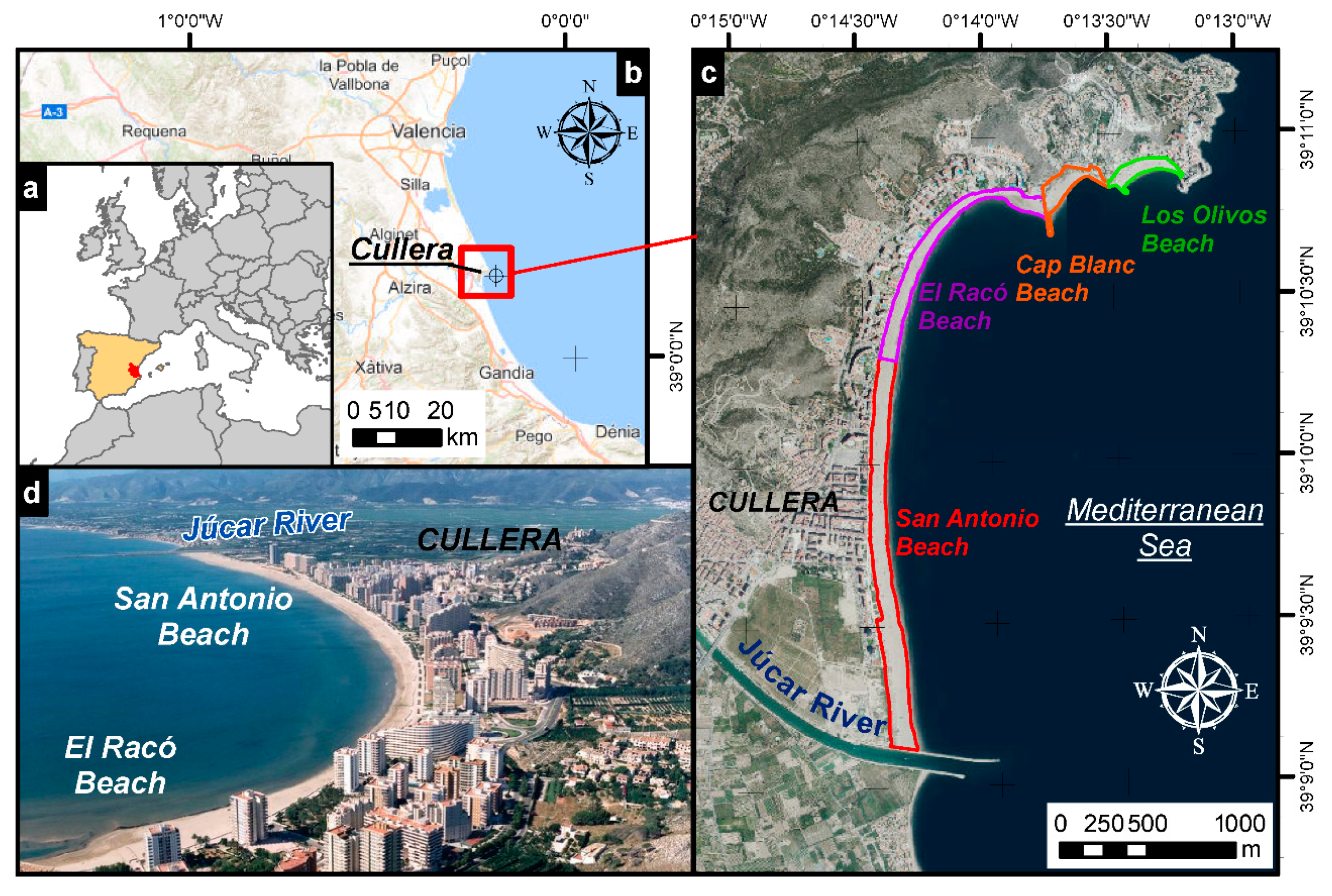
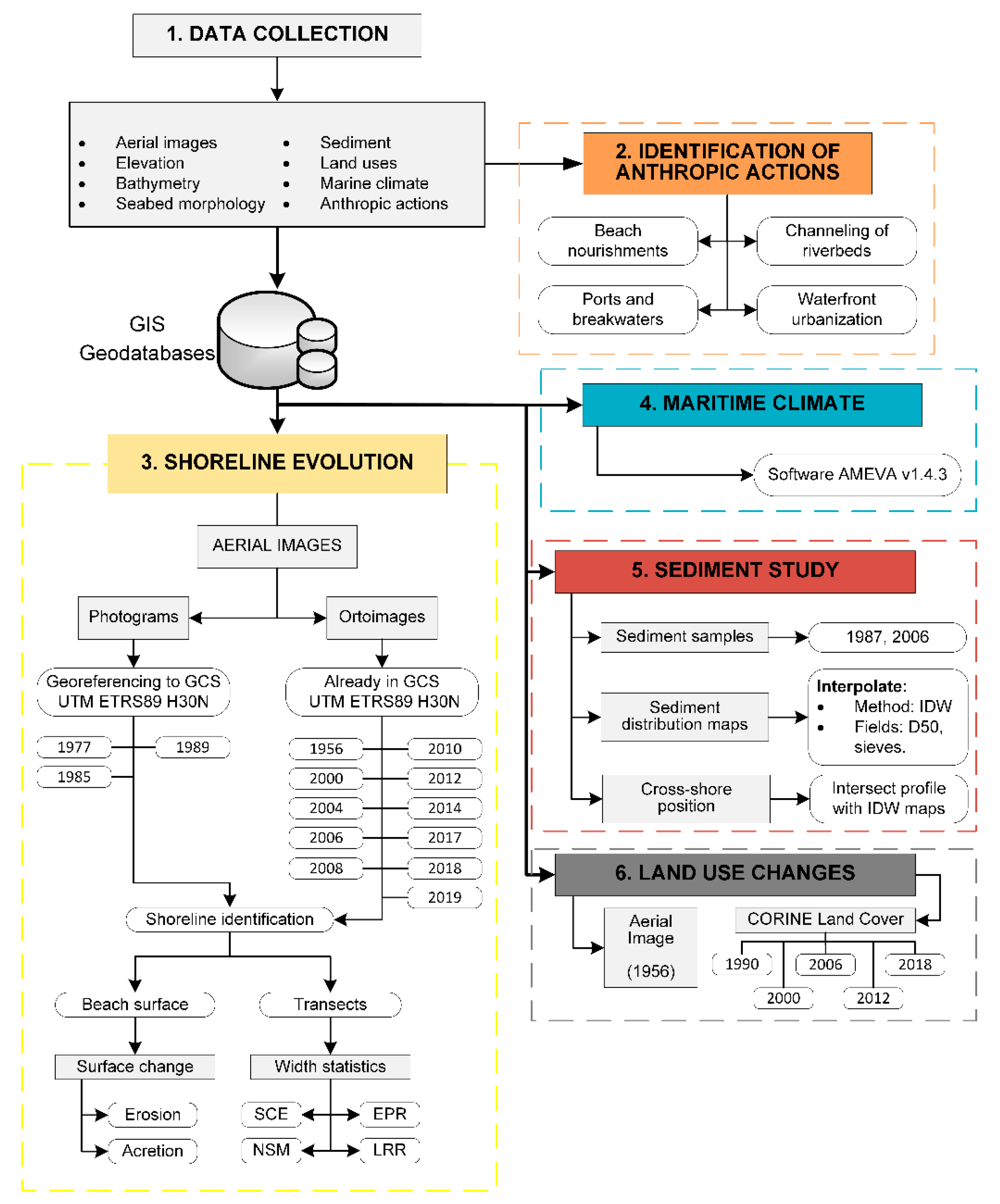
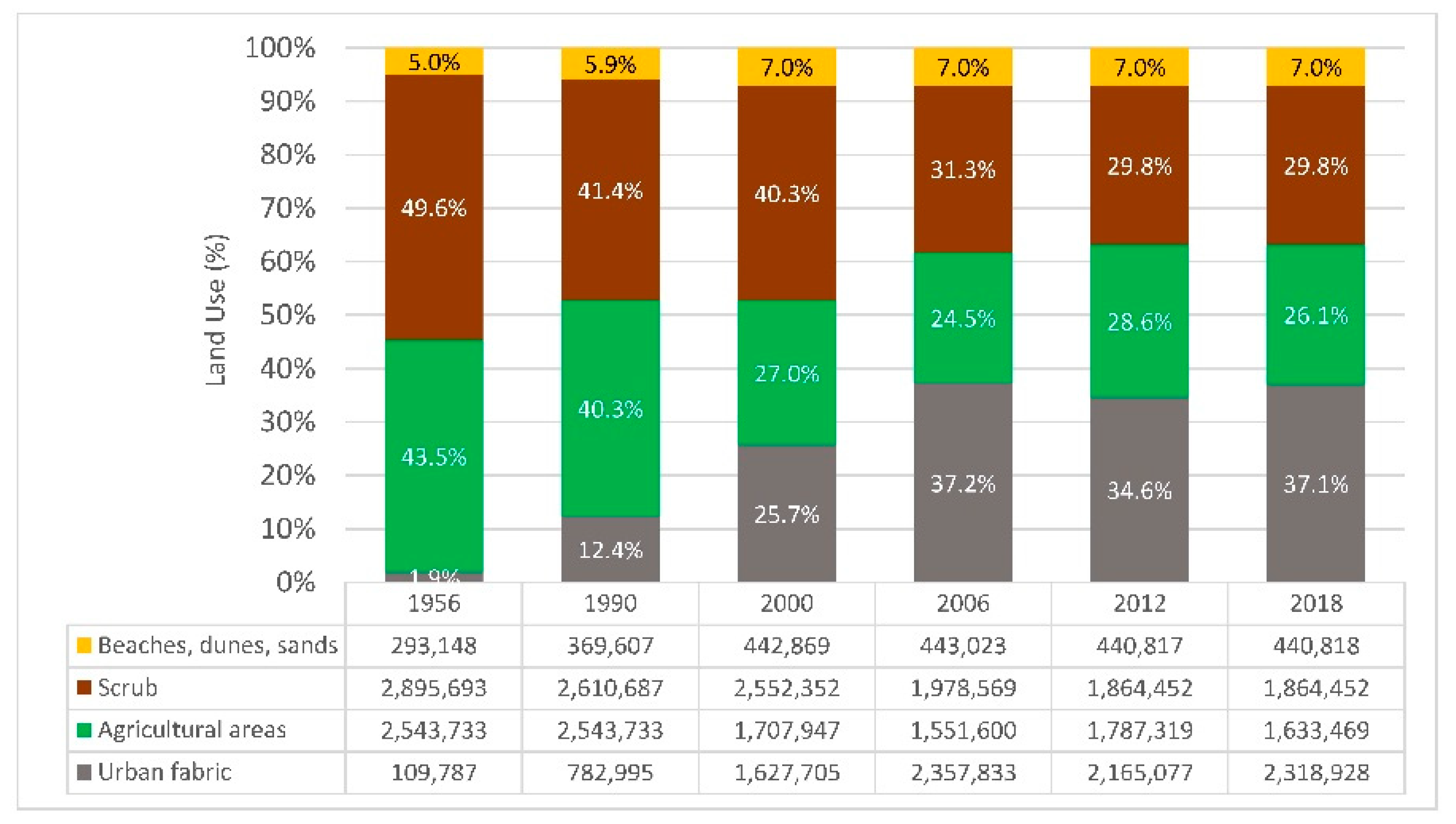
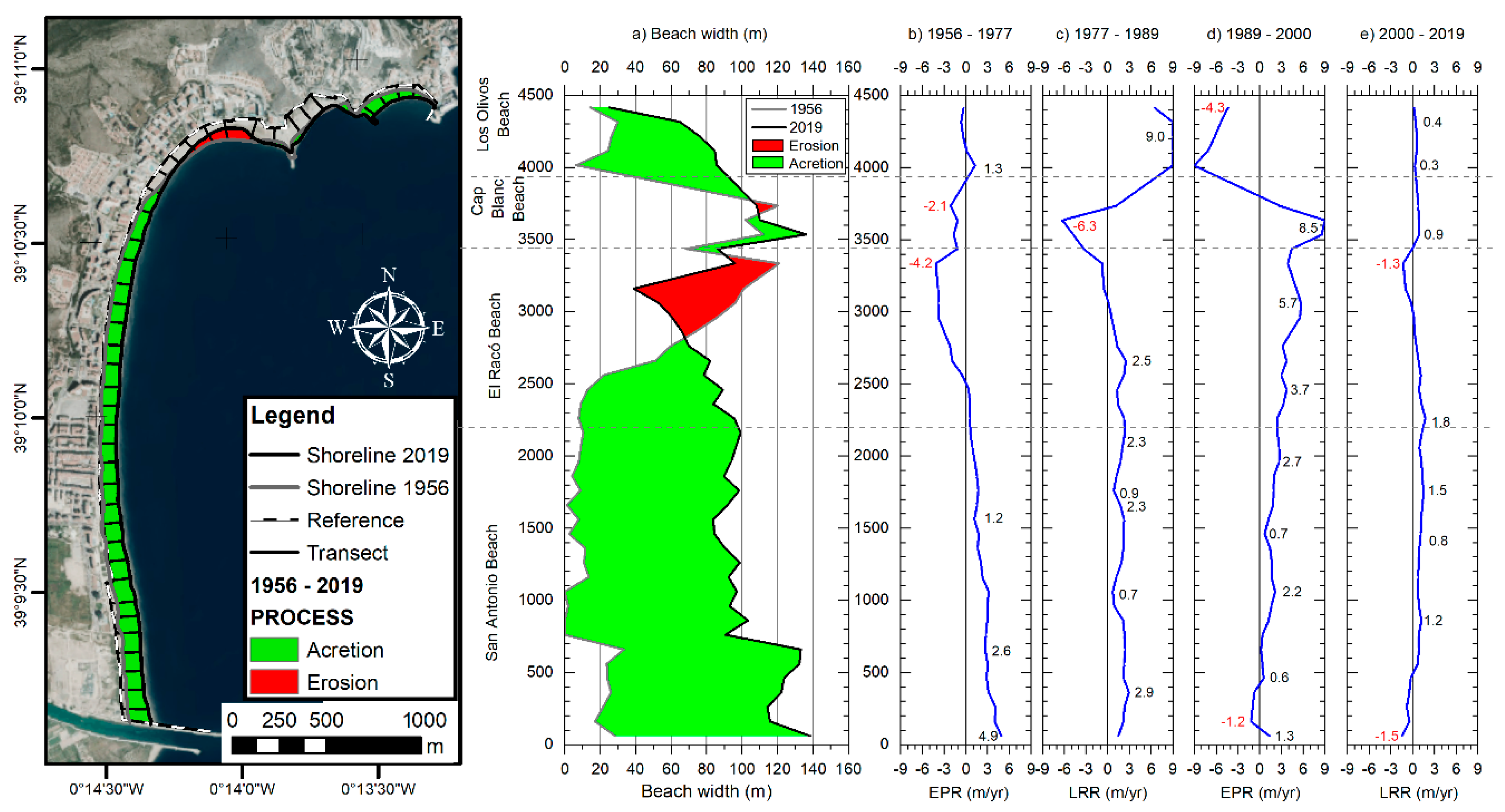

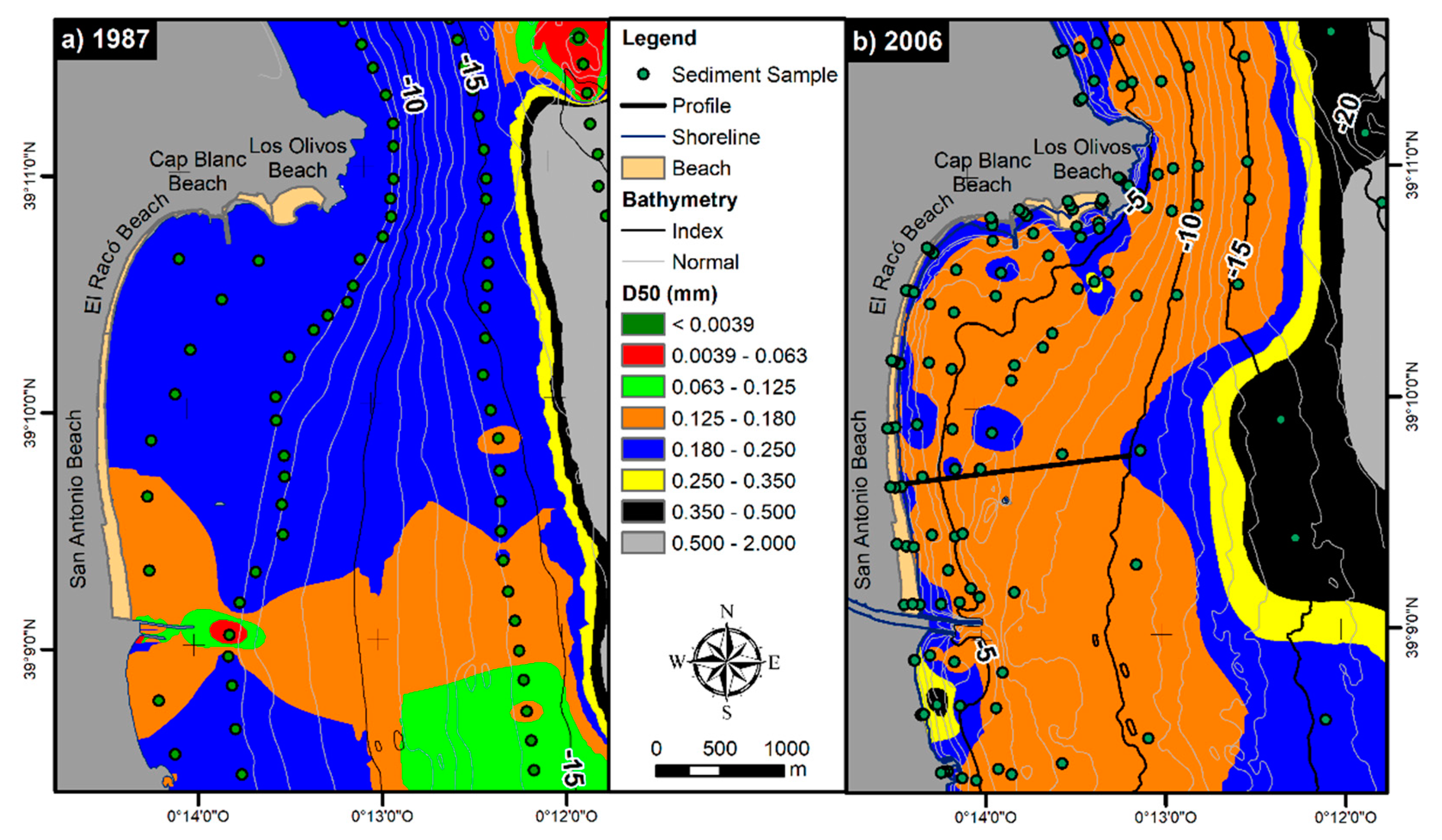
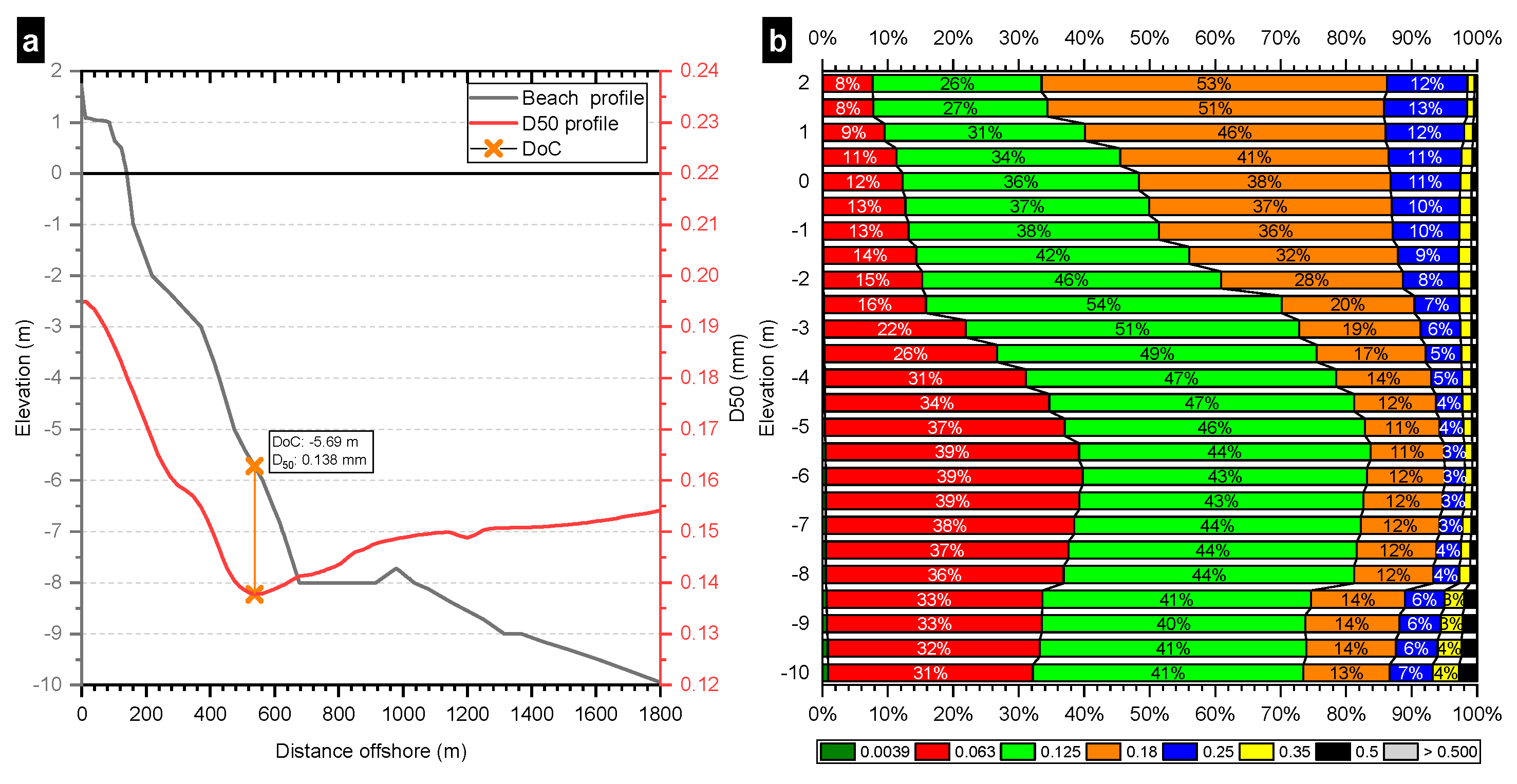
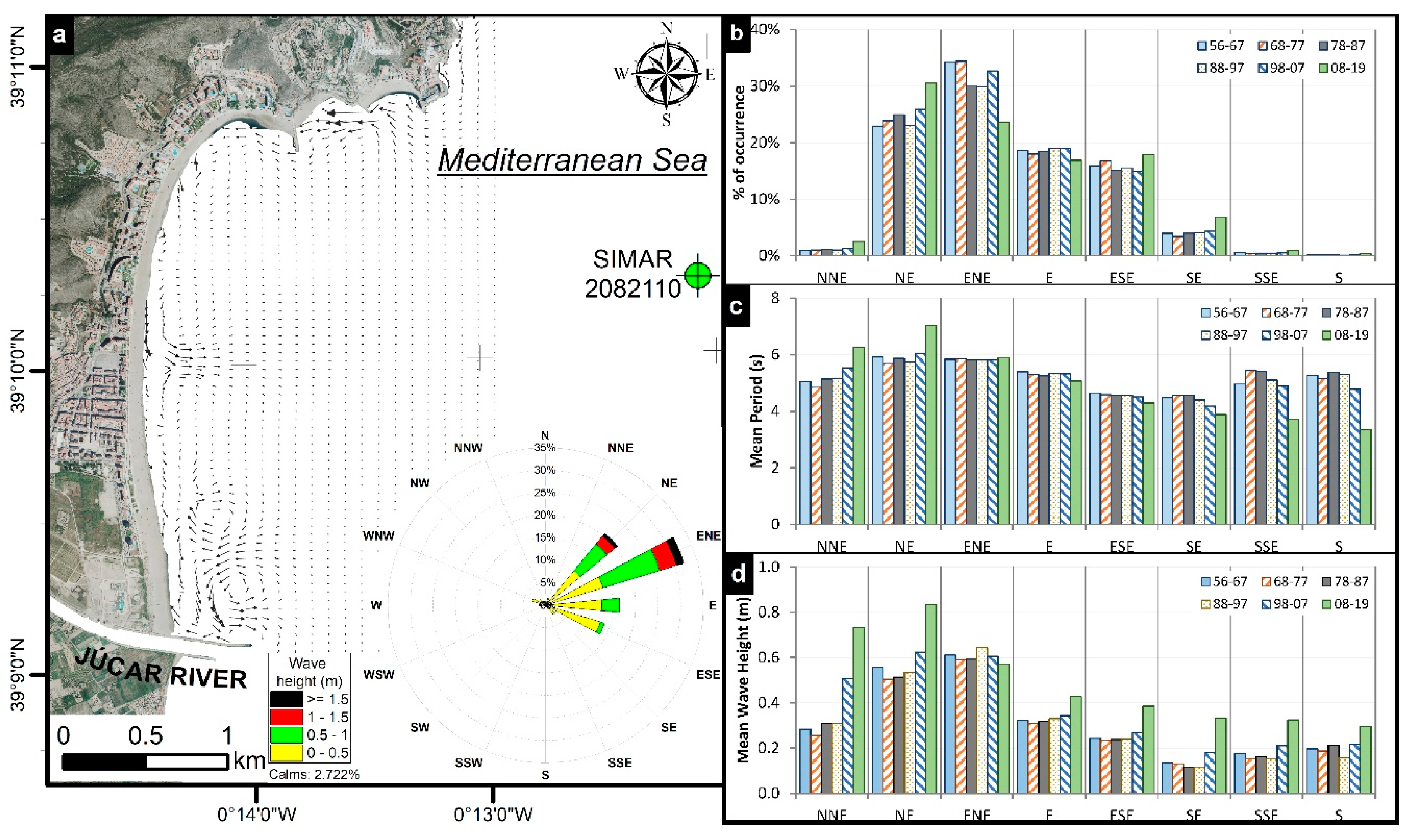
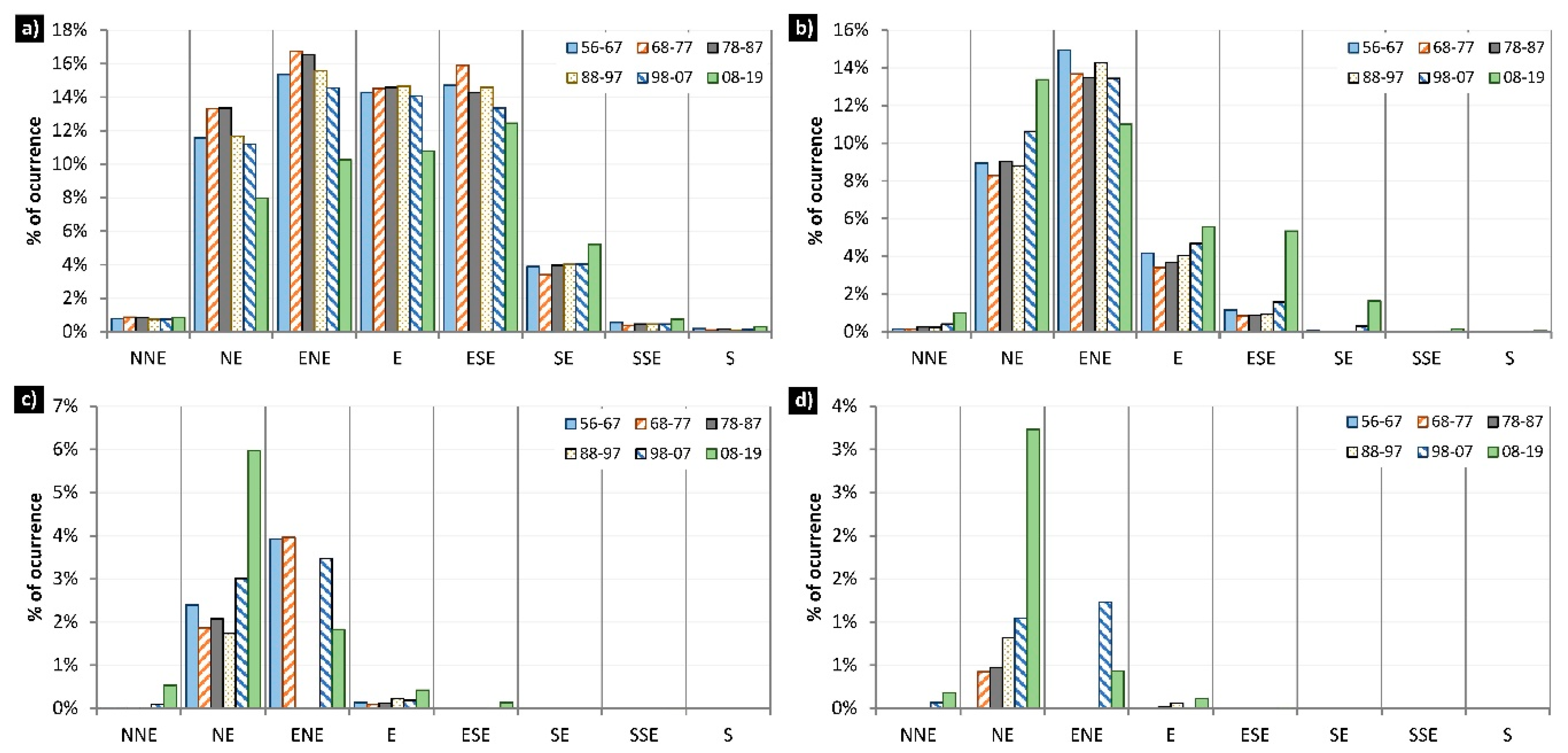
© 2020 by the authors. Licensee MDPI, Basel, Switzerland. This article is an open access article distributed under the terms and conditions of the Creative Commons Attribution (CC BY) license (http://creativecommons.org/licenses/by/4.0/).
Share and Cite
Pagán, J.I.; López, I.; Bañón, L.; Aragonés, L. Consequences of Anthropic Actions in Cullera Bay (Spain). J. Mar. Sci. Eng. 2020, 8, 240. https://doi.org/10.3390/jmse8040240
Pagán JI, López I, Bañón L, Aragonés L. Consequences of Anthropic Actions in Cullera Bay (Spain). Journal of Marine Science and Engineering. 2020; 8(4):240. https://doi.org/10.3390/jmse8040240
Chicago/Turabian StylePagán, José Ignacio, Isabel López, Luis Bañón, and Luis Aragonés. 2020. "Consequences of Anthropic Actions in Cullera Bay (Spain)" Journal of Marine Science and Engineering 8, no. 4: 240. https://doi.org/10.3390/jmse8040240
APA StylePagán, J. I., López, I., Bañón, L., & Aragonés, L. (2020). Consequences of Anthropic Actions in Cullera Bay (Spain). Journal of Marine Science and Engineering, 8(4), 240. https://doi.org/10.3390/jmse8040240







